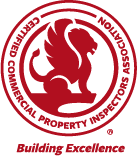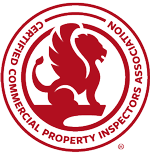Sewer scope or plumbing scope inspections could be the most crucial ancillary inspection service that a commercial inspector can offer their clients. This inspection involves using a flexible borescope camera to visually examine the interior of the building’s drain line.
Beyond the Visual Inspection
Commercial property inspections involve visually inspecting the accessible parts of a building. Inspectors are not required to dismantle systems or components or to perform technically exhaustive tasks. Inserting a camera into the plumbing system goes beyond the scope of the International Standards of Practice for Inspecting Commercial Properties (ComSOP), so it is considered an ancillary service. Using a camera to assess the plumbing system can provide a very valuable service and potentially save your client tens of thousands of dollars.
What Is a Sewer Scope?
A sewer scope involves inserting a borescope (camera) into the plumbing system through a cleanout or other readily accessible opening. Depending on the building and the goal for the inspection, some typical points of insertion could include floor or wall cleanouts, roof drain cleanouts, catch basins, or drains. The diameter of the camera and the length of the cable attached to the camera can limit where the inspection can be performed. Larger cameras could be mounted on small robots and placed in large pipes. Small to medium-sized units are pushed by hand and used in the main building sewer, whereas smaller cameras could be used in drains as small as those located under a sink.
The camera is connected to a video screen, which may be a tablet, phone, or a different system, depending on the size of the camera. The inspector can monitor the screen and examine the condition of the interior of the pipe as seen through the camera.
The camera is manually pushed through the pipe so that the inspector can view and interpret the conditions present. The goal is to see if the interior of the pipe is smooth, free of any debris and blockages, and well-draining. A well-draining pipe will not have any standing water in it. Standing water in a drainpipe is an indication of a blockage or a poorly sloped pipe, both of which can prevent the pipe from functioning as intended.
Most sewer cameras have built-in features to help identify the location of any issues present. These may include measurement counters built into the cables. As the inspector pushes the camera through the pipe, a counter measures exactly how far the camera is from the point of origin. This feature provides a specific location that can be found later when a repair might need to be made at that spot.
What Conditions Might Be Discovered?
The importance of having a sewer scope performed is almost invaluable because it can detect issues that cannot be seen during a visual-only inspection. Because the sewer or plumbing system is located underground, problems can be present for years until they finally emerge as a potential catastrophe.
One such catastrophe could be the structural movement of the building. Some sewer or plumbing pipes exit from the building under the footing. The footing is the structural foundation on which the entire building rests. A small leak in the plumbing in the area of the footing can, over time, erode the soil around the footing. This erosion will cause the footing to lose its stability and begin to move. The movement of the footing can cause the foundation that it supports to crack and move. The foundation may then develop cracks in the sidewalls, and the building will begin to shift, possibly leading to the building’s collapse. Without a sewer scope, signs of this potential issue might never be seen until it’s too late.
In older buildings, it is common to find large cast-iron pipes used as the venting portion of the plumbing system. These buildings, especially older multi-family, multi-floor buildings, may have undergone localized updates over the years, but the entire system is often not fully updated. As a result, the shifting of vent pipes can cause the seals to loosen, leading to a loss of integrity in the vent system and allowing sewer gases to escape into the building walls. One way to check the integrity of the pipes and detect any issues is by inserting a sewer scope down the vent stack located on the roof. This can verify the condition of the pipe and identify any problems.
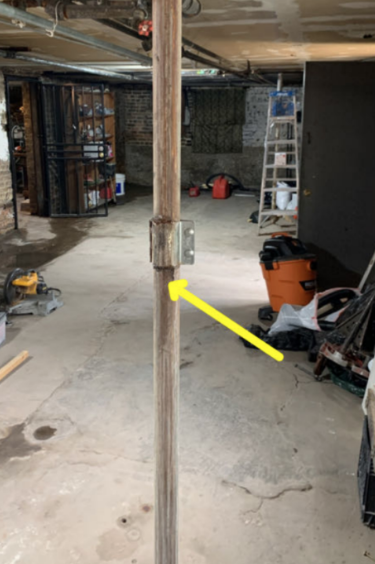
Older building with a previously repaired drainpipe. This could be an indication of other conditions that might not be readily accessible.
Low-sloped roofs often have an internal drain system that drains downward into the building and possibly under the floor. This system may not be directly connected to the sewer, but once it migrates under the floor, it becomes totally inaccessible. In a commercial building, heavy machinery or forklifts may carry materials from one part of the building to another, requiring the floor to be sound and stable. If the underground pipe has any issues, it can cause the floor to become unstable and potentially collapse. Not only would this issue be expensive to repair, but it would also disrupt business operations, which would incur additional costs. By placing a sewer camera into the cleanout of the roof drain system, any issues can be detected long before the floor shows signs of failure.
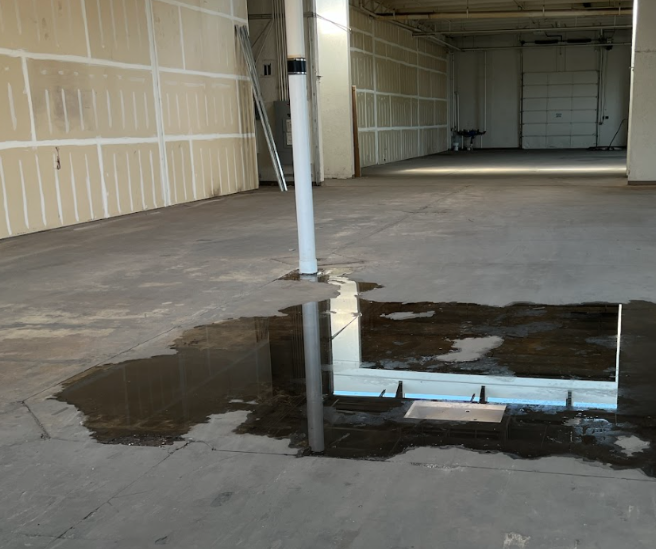
Leaking roof drainpipe that is leaking at or below the concrete floor
Tree root intrusion or simple blockages are the most common conditions an inspector might encounter while performing a sewer scope inspection. This occurs when a tree that’s located between the building and the sewer connection has its roots growing into the sewer pipe. The tree roots seek a source of water, and the sewer pipe becomes the best option. As a result, the tree roots will grow inside the pipe, causing it to no longer drain properly. Simple blockages may not necessarily be caused by tree roots but could be from a buildup of grease, fats or oils, as well as other impediments.
Conditions that could be discovered with a sewer camera inspection include:
- Blockages: This covers anything in the pipe that could block the flow of water or waste.
- Cracked pipes: Pipe failure can occur for various reasons. Without the use of a camera, these cracks might never be discovered.
- Damaged pipes: This could include the crushing of the pipe from the forces of weight placed upon it. A crushed pipe could result in a constriction of its diameter, thus reducing the flow.
- Sagging pipes: A pipe that sags develops bellies or pockets where the flow can be interrupted.
- Collapsed pipes: This occurs when the pipe is in total failure.
- Corrosion: Depending on the pipe’s material, it can be subject to corrosion. This could include rusting cast-iron or steel pipe, or chemical corrosion in other pipes.
- Joint defects: No pipe is continuous. There are connections installed between pipes. This is often the prime location where roots can enter or water can escape. Additionally, this is where pipes can show movement and become offset.
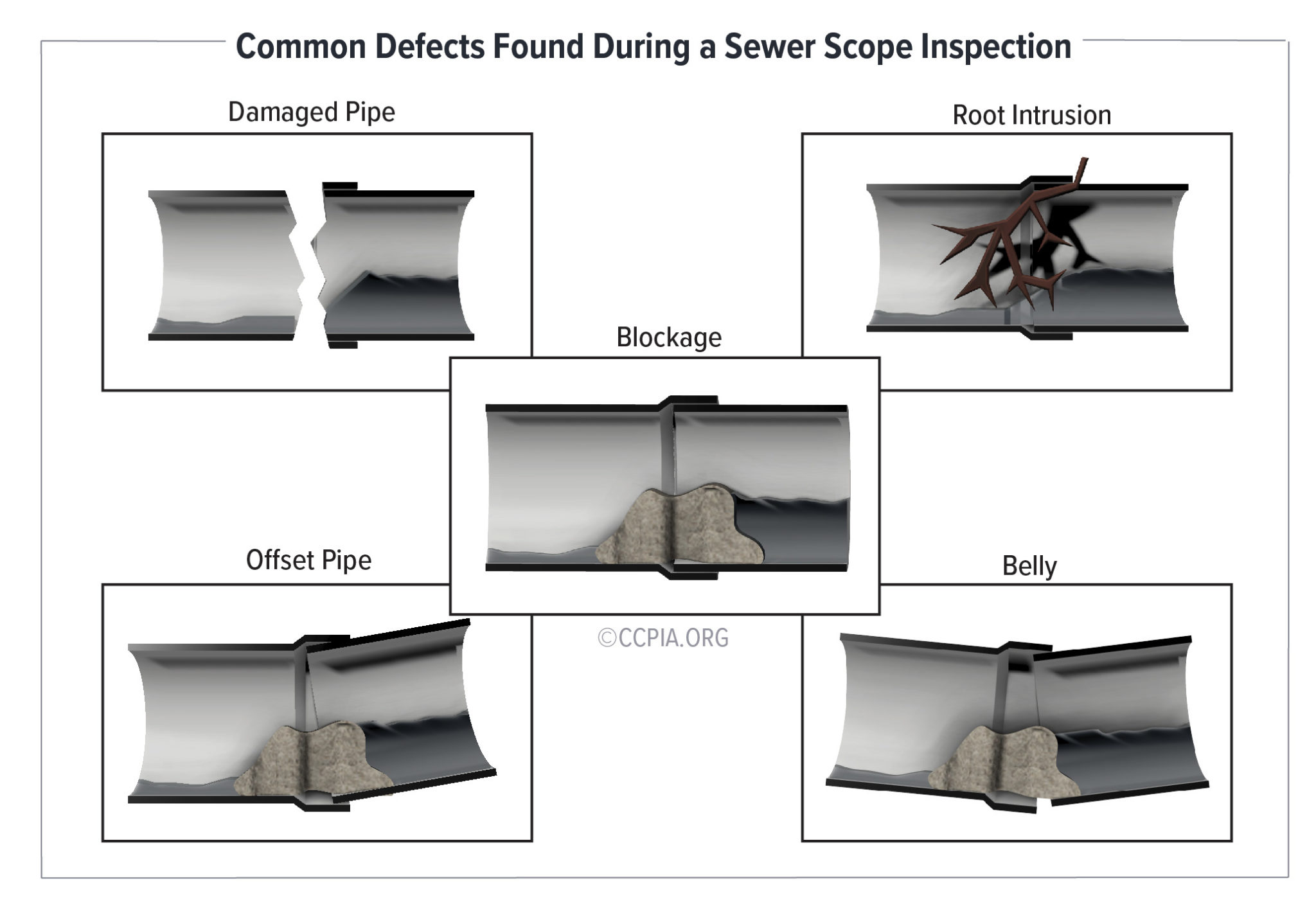
Who Can Perform Sewer Scopes?
Some areas mandate that individuals offering this service must be licensed plumbers, while other jurisdictions recognize that this is a visual inspection and not an actual plumbing service. Most inspectors are not licensed plumbers, so this type of service or inspection is for the client’s informational purposes only. When inspectors discover conditions that require attention, they should recommend further evaluation by a licensed plumber. Some commercial property inspectors opt to contract plumbers or companies specializing in commercial sewer scope inspections instead of performing the sewer scope themselves.
What’s Next?
Inspectors interested in pursuing sewer scope inspections have two options to consider. The first option is to partner with someone who is already conducting these inspections. This would enable the commercial property inspector to offer this important service without needing to be licensed or certified to perform the task.
Another approach is to become qualified to conduct the inspections independently. This would involve obtaining the necessary training not only to perform the inspections but also to interpret what is being shown on the video screen. Inspectors who are looking for additional training should consider attending a class at one of InterNACHI’s House of Horrors® locations. (Click here for more information: https://www.nachi.org/house-of-horrors/sewer-scope-training.)
Sewer scope inspections can provide valuable information to the client about the condition of pipes that are not readily accessible. This inspection can also be a profitable ancillary service for the inspection company and provide a secondary source of revenue, in addition to the standard inspection fee. Regardless of the reason an inspector chooses to perform sewer scope inspections, the client will benefit from purchasing this service.
Article Written By: Rob Claus
Additional Resources for Commercial Property Inspectors:
